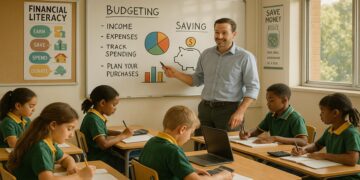Financial Education in Schools: Preparing the Future Generation for Economic Challenges in Australia

The Importance of Financial Literacy in Education
In Australia, young adults are increasingly confronted with economic pressures that demand a fundamental understanding of financial principles. High living costs, particularly in major cities like Sydney and Melbourne, alongside soaring student debts, create a financial landscape fraught with challenges. As high school students transition to university and the workforce, they need more than academic qualifications; they require practical financial skills to thrive in an ever-changing economy. By embedding financial education in school curriculums, we can ensure that future generations are well-equipped to face these trials.
Financial literacy encompasses a variety of essential skills that lay the groundwork for sound money management. Among the most crucial are:
- Budgeting: This involves creating a plan for managing income and expenses. For young Australians, understanding how to allocate funds effectively can prevent living paycheck to paycheck. They can learn how to track their spending with apps or spreadsheets, allowing them to prioritize needs over wants.
- Saving: Establishing a habit of saving is vital for achieving long-term goals, whether it’s a first car, travel abroad, or a deposit on a home. Financial education can instill the importance of an emergency fund, equipping students with strategies to save consistently, even on a modest income.
- Investing: Building wealth through smart investments is a key component of financial success. Educating students about stock markets, mutual funds, and other investment vehicles can demystify these concepts and encourage them to think long-term regarding financial growth.
- Debt management: As many young Australians grapple with accumulating student debt, understanding how to manage loans and credit responsibly becomes paramount. Lessons could cover the implications of interest rates and the importance of making timely repayments to avoid crippling financial stress.
As Australia faces ongoing economic uncertainties, it’s imperative that students cultivate a strong financial foundation for their academic and professional futures. Initiating discussions about finances in schools fosters a sense of responsibility regarding financial choices—students are more likely to see the value in planning for their financial futures and become proactive in their decision-making. Moreover, instilling a positive attitude towards money management promotes better financial behaviors, laying the groundwork for responsible stewardship of personal and communal wealth.
In this article, we will delve deeper into the various facets of financial education within Australian schools, illustrating its role in shaping a financially literate generation that can tackle economic challenges with confidence and resilience. By empowering students with knowledge and skills, we pave the way for sustainable economic growth and stability in our communities.
Integrating Financial Education in the Curriculum
The integration of financial education into the school curriculum is a vital step towards equipping students with the knowledge they need to navigate their financial futures successfully. Many Australian schools are beginning to recognize the importance of teaching financial literacy as part of a holistic education, which extends beyond traditional subjects like mathematics and science. This approach encourages a more practical understanding of money management and fosters essential skills needed to meet the economic realities of adulthood.
One of the key aspects of implementing financial education in schools is the development of a comprehensive curriculum that can be adapted to various age groups. Introducing basic concepts in primary schools can set a solid foundation; for example:
- Understanding Money: Students can learn the history of money, the role it plays in our society, and simple concepts such as saving and spending.
- Simple Budgeting Techniques: Children can be taught how to use pocket money wisely, including distinguishing between needs and wants.
- Basic Math Skills: Practical math lessons can include calculating discounts during shopping or figuring out how much they save when they use coupons.
As students progress into secondary education, the curriculum can advance to cover more complex financial topics. For instance:
- Real-Life Financial Scenarios: This might include understanding household budgets, managing a part-time job’s income, or the necessary expenses associated with attending university.
- Investment Basics: Students can be introduced to the principles of investing, including the stock market, compound interest, and different asset classes.
- Debt Responsibility: Lessons on the impact of credit scores and the importance of managing debt responsibly can help students avoid pitfalls associated with loans and credit cards.
Embedding these components into existing subjects, such as mathematics or social studies, can foster a more engaging learning experience. Furthermore, incorporating interactive elements like project-based learning, in which students develop their business plans or budgeting projects, can reinforce their understanding and encourage application of the concepts learned. This not only cultivates practical skills but also sparks an interest in financial matters that can last a lifetime.
However, for financial education to be effective, teacher training is equally important. Educators must be equipped with the tools and resources to teach with confidence. Professional development opportunities and access to up-to-date materials can ensure educators feel competent in delivering financial education content. When teachers believe in the importance of financial literacy, they can inspire students to take their financial futures seriously.
By prioritizing financial education within schools, Australia is making significant strides towards preparing its future generation for the economic challenges ahead. The goal is to develop a generation of financially literate individuals who can not only survive but thrive in an increasingly complex financial world.
The Role of Parents and Community in Financial Education
While schools play a pivotal role in imparting financial education, the involvement of parents and the community is essential in reinforcing these lessons. A collaborative approach ensures that financial literacy transcends the classroom and becomes an integral part of a child’s daily life. Parents can help bridge the gap by discussing financial matters openly at home, setting a foundation where children feel comfortable asking questions and seeking guidance.
One effective way for parents to influence their children’s financial education is through everyday activities. For instance, taking children grocery shopping presents an excellent opportunity to teach them about budgeting. Parents can explain the importance of comparing prices and choosing products that provide the best value for money. This experience allows students to apply the theoretical knowledge they acquire in school to real-world situations, enhancing their understanding of financial decision-making.
In addition to parental involvement, community programs and local organizations can further support financial literacy initiatives. Many nonprofit organizations in Australia offer workshops and resources aimed at both children and adults. These programs can include interactive seminars that cover topics such as savings strategies, investment options, and credit management, allowing families to learn together.
Moreover, community involvement can bring financial education to life through partnerships with local businesses. Schools can collaborate with community banks or financial institutions to host events like ‘Financial Literacy Days,’ where students participate in simulations and role-playing activities that mimic real-life financial decisions. This hands-on approach not only makes learning more engaging but also helps to demystify finance, making it more accessible for young minds.
Technology also plays a significant role in enhancing financial education outside the classroom. There are numerous apps and online platforms designed specifically to teach financial literacy to both children and adults. These tools can help families keep track of expenses, set goals, and learn about investing through gamified experiences that encourage participation. Integrating technology into financial education can especially resonate with younger generations who are more comfortable with digital learning environments.
In Australia, government efforts are also essential in promoting financial education. Initiatives like the National Financial Literacy Strategy aim to provide a coordinated approach to improve financial literacy across various community sectors. Support from the government can include funding for educational programs, creating awareness campaigns, and providing resources for schools to effectively teach financial literacy. This comprehensive strategy encourages a cultural shift regarding financial education, making it a priority not just within schools, but across society.
Ultimately, the combined efforts of schools, parents, community organizations, and government can build a robust framework for financial education. By working together, they can create a supportive environment where children can develop vital skills, enabling them to face future economic challenges with confidence. The groundwork laid through these collaborative efforts will serve as a critical foundation for a financially literate generation ready to navigate an increasingly complex world.
Conclusion
In conclusion, the need for financial education in schools is more pressing than ever, as we equip the future generation of Australians to tackle an increasingly complex economic landscape. By integrating financial literacy into the educational curriculum, we are laying the groundwork for our children to make informed decisions about money, paving the way for their long-term success. It is imperative that schools, along with parents, local communities, and the government, collaborate to create an ecosystem that fosters financial knowledge from an early age.
The inclusion of practical experiences, such as budgeting during everyday activities and engaging with community programs, helps children relate theoretical knowledge to real-life situations. These initiatives can significantly boost their confidence in managing finances, thereby reducing financial anxiety in adulthood. Moreover, leveraging technology to enhance learning ensures that financial education resonates with younger generations who are accustomed to digital tools.
As Australia moves forward, we must recognize that financial literacy is not just a skill, but a vital component of personal and societal well-being. By making financial education a priority, we can cultivate a generation of well-informed, responsible citizens who can navigate economic challenges with resilience and foresight. Together, let us champion the cause for comprehensive financial education—an investment in our children’s futures and, ultimately, the economic prosperity of Australia as a whole.

James Carter is a financial writer and advisor with expertise in economics, personal finance, and investment strategies. With years of experience helping individuals and businesses make complex financial decisions, James offers practical insight and analysis. His goal is to give readers the knowledge they need to achieve financial success.






